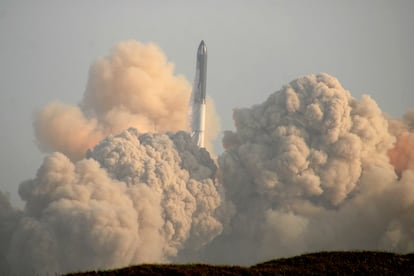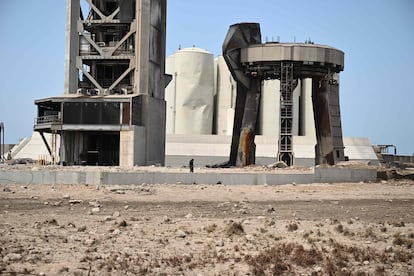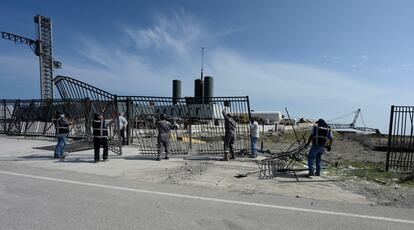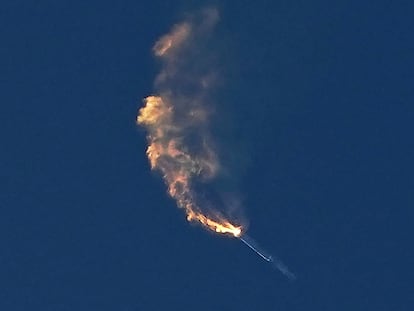‘Starship’ explosion: NASA on alert over launch pad destruction as Artemis faces delays
SpaceX engineers are facing a serious problem that will have an immediate impact on the U.S. space agency’s plans to send astronauts back to the Moon in 2025

As SpaceX quality systems engineer said after the historic launch of Elon Musk’s Starship: “Everything after clearing the tower was icing on the cake.” The rest of the objectives in the company’s first test flight of the 120-meter rocket were secondary. SpaceX’s biggest fear was that the vehicle would collapse on its launch ramp. It had happened before: in July 1969, at the height of the space race, the USSR launched its second N-1, the rocket developed to carry a Russian cosmonaut to the Moon. Just 10 seconds after liftoff, nearly all 30 first-stage engines were shut down and the vehicle plunged back onto its launch pad. The explosion completely destroyed the N-1, and it took a year and a half to rebuild it.
Fortunately for SpaceX, Starship cleared the tower, prompting cheers and applause from company personnel following a livestream of the launch. But subsequent analysis has shown that the infrastructure suffered serious damage. Under the “stool” that serves as a seat for the rocket, the exhaust of the engines blasted a crater that exposed the foundations. The impact of the 33 Raptor 2 engine flares on the ground beneath the platform has had a devastating effect. The concrete used cracked up and large chunks flew in all directions, causing a monumental bombardment hundreds of meters away. Some hit the methane and oxygen tanks installed a short distance from the tower, denting them but apparently not causing any serious damage. Images obtained by a remote camera show a hailstorm of fragments, some of which hit a car parked nearby.
VR Cam caught some spectacular footage as #SuperHeavy rocked #SpaceX #Starbase this morning. I am floored at the amount of debris that was ejected. Waiting on Rover 2 damage assessment. Congratulations @elonmusk on pulling this historical launch! pic.twitter.com/6WKEXFqCGN
— LabPadre (@LabPadre) April 20, 2023
SpaceX platform destruction raises concerns
Given the scale of the destruction, many observers have wondered why a flame deflector was not installed under the launch pad. At NASA’s Kennedy Space Center, for example, ramps 39A and B — from which the Saturn V and the Space Shuttle program, and last November the Space Launch System (SLS) that will carry astronauts back to the Moon, lifted off — contain a Flame Trench-Deflector System, which consists of a massive inverted V-shaped structure that is installed directly under the rocket exhausts. At liftoff, the flares hit the walls of the deflector and are redirected by two horizontal side ditches so that they do not blast the ground beneath the launch pad.
Most launch pads also have a water flooding system, not only to combat the heat of the exhaust, but also to dampen the effects of noise. The millions of bubbles of liquid absorb some of the sonic energy and protect the rocket itself from impact. The intensity of the thunderous roar is more than the air around it can withstand: it is no longer mere noise, but produces a brutal pressure wave that bounces off the ground and threatens to damage the very engines that produce it.

SpaceX’s launch platform in Boca Chica, Texas, lacked a deflector and only deployed a sprinkler system directed towards the rocket nozzles. Apparently, SpaceX believed that the concrete slab, which is made of Fondag, a heavy-duty concrete that is resistant to high temperatures, could withstand at least one launch.
Musk tweeted the day after the launch: “3 months ago, we started building a massive water-cooled, steel plate to go under the launch mount. Wasn’t ready in time & we wrongly thought, based on static fire data, that Fondag would make it through 1 launch.” It was an error that may have unforeseen consequences, although the SpaceX owner said the platform would be ready for another launch within one to two months.
However, it is doubtful that the Federal Administration will authorize the launching of another Starship until the problem is completely solved. And that implies considerable modifications to the structures at Boca Chica. Meanwhile, NASA will be adjusting the brand-new launch tower erected at the Kennedy Center, almost next to pad 39A, the historic ramp from which Apollo missions to the Moon lifted off. SpaceX leases it from the agency and regularly launches its Falcon rockets from there.
Liftoff from Starbase pic.twitter.com/rgpc2XO7Z9
— SpaceX (@SpaceX) April 20, 2023
Delays to NASA Artemis missions likely
NASA officials have warned SpaceX that a Starship explosion at Launch Complex 39A at a stroke cut off the agency’s only means of launching U.S. astronauts to the International Space Station. “It would be pretty devastating for 39A,” Kathy Lueders, associate administrator of NASA’s Space Operations Mission Directorate, said about the agency’s discussions with SpaceX.
Other than a flame deflector, is there another solution for SpaceX? When the Saturn V launch facilities were built half a century ago, a determining factor was precisely the size of the flame deflector, which stood at 12 meters high. This conditioned the height of the platform as well as the width of the gas evacuation channels. This was all constructed above ground as Cape Canaveral, located next to a beach, was not suitable for deep excavations.

The problem facing SpaceX is that the Boca Chica launch tower and pedestal have been built in very similar conditions, right next to the beach. There is barely room for a deflector, and it will be very problematic to dig flame trenches. The addition of a water flooding system, although feasible, will take time. And the same is true of the facilities being built at the Kennedy Center.
Unless Musk pulls some revolutionary idea out of his hat, it seems that the only solution is a metal deflector shield under the rocket. However, some experts have already noted that a steel plate of such dimensions, subjected to the tremendous heat of the rocket’s exhaust for 10 to 15 seconds, will undergo such sudden expansion that it will fracture, handing SpaceX engineers a serious problem.
For now, delays in SpaceX’s Starship development will have an immediate impact on NASA’s plans. A variant of this vehicle has been selected to carry astronauts to the surface of the Moon in 2025 as part of NASA’s Artemis program. If there were already doubts about the feasibility of that date, the result of this first test flight now makes it almost impossible.
Sign up for our weekly newsletter to get more English-language news coverage from EL PAÍS USA Edition
Tu suscripción se está usando en otro dispositivo
¿Quieres añadir otro usuario a tu suscripción?
Si continúas leyendo en este dispositivo, no se podrá leer en el otro.
FlechaTu suscripción se está usando en otro dispositivo y solo puedes acceder a EL PAÍS desde un dispositivo a la vez.
Si quieres compartir tu cuenta, cambia tu suscripción a la modalidad Premium, así podrás añadir otro usuario. Cada uno accederá con su propia cuenta de email, lo que os permitirá personalizar vuestra experiencia en EL PAÍS.
¿Tienes una suscripción de empresa? Accede aquí para contratar más cuentas.
En el caso de no saber quién está usando tu cuenta, te recomendamos cambiar tu contraseña aquí.
Si decides continuar compartiendo tu cuenta, este mensaje se mostrará en tu dispositivo y en el de la otra persona que está usando tu cuenta de forma indefinida, afectando a tu experiencia de lectura. Puedes consultar aquí los términos y condiciones de la suscripción digital.
More information
Archived In
Últimas noticias
Most viewed
- Reinhard Genzel, Nobel laureate in physics: ‘One-minute videos will never give you the truth’
- Oona Chaplin: ‘I told James Cameron that I was living in a treehouse and starting a permaculture project with a friend’
- Pablo Escobar’s hippos: A serious environmental problem, 40 years on
- Charles Dubouloz, mountaineering star, retires at 36 with a farewell tour inspired by Walter Bonatti
- Why we lost the habit of sleeping in two segments and how that changed our sense of time











































